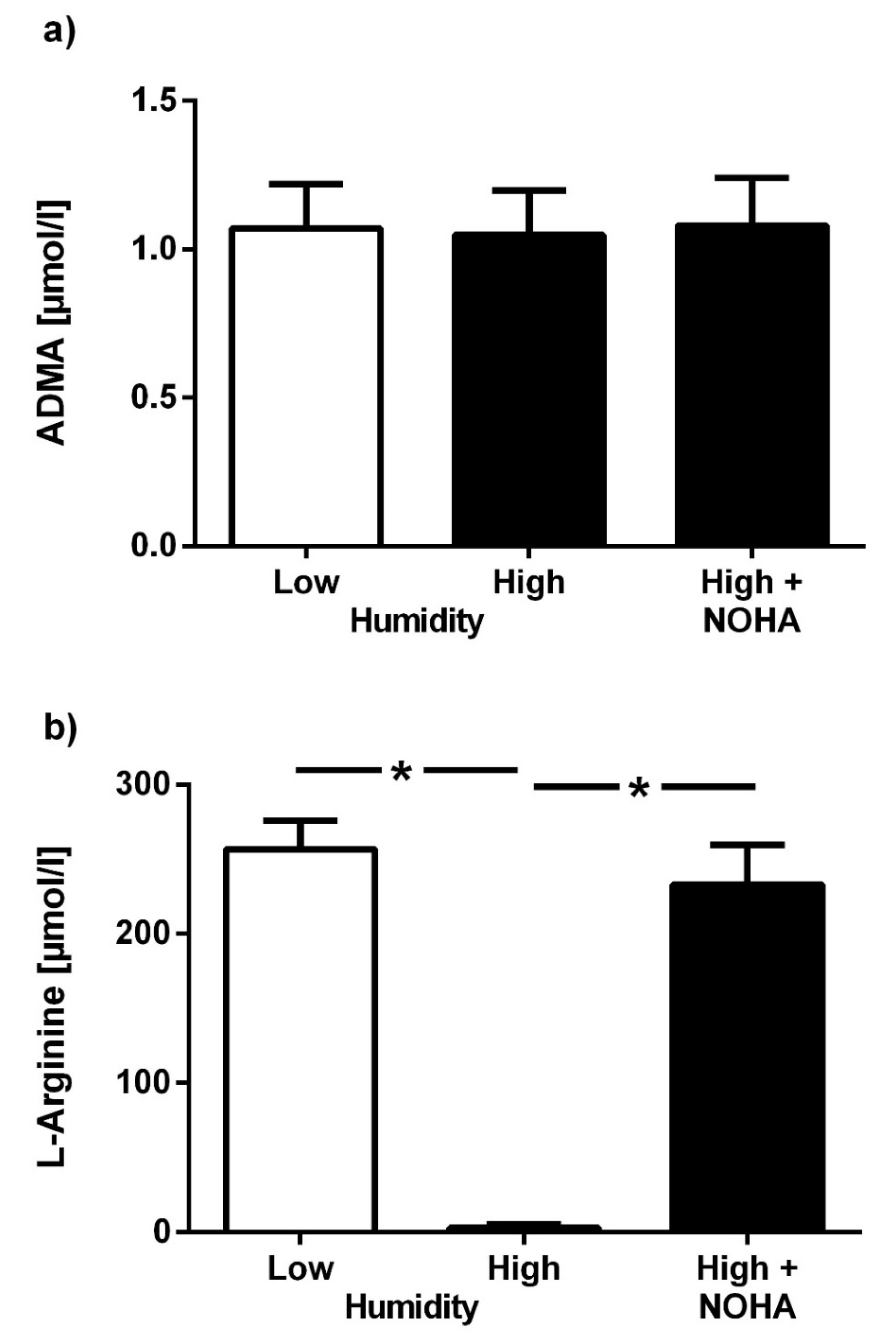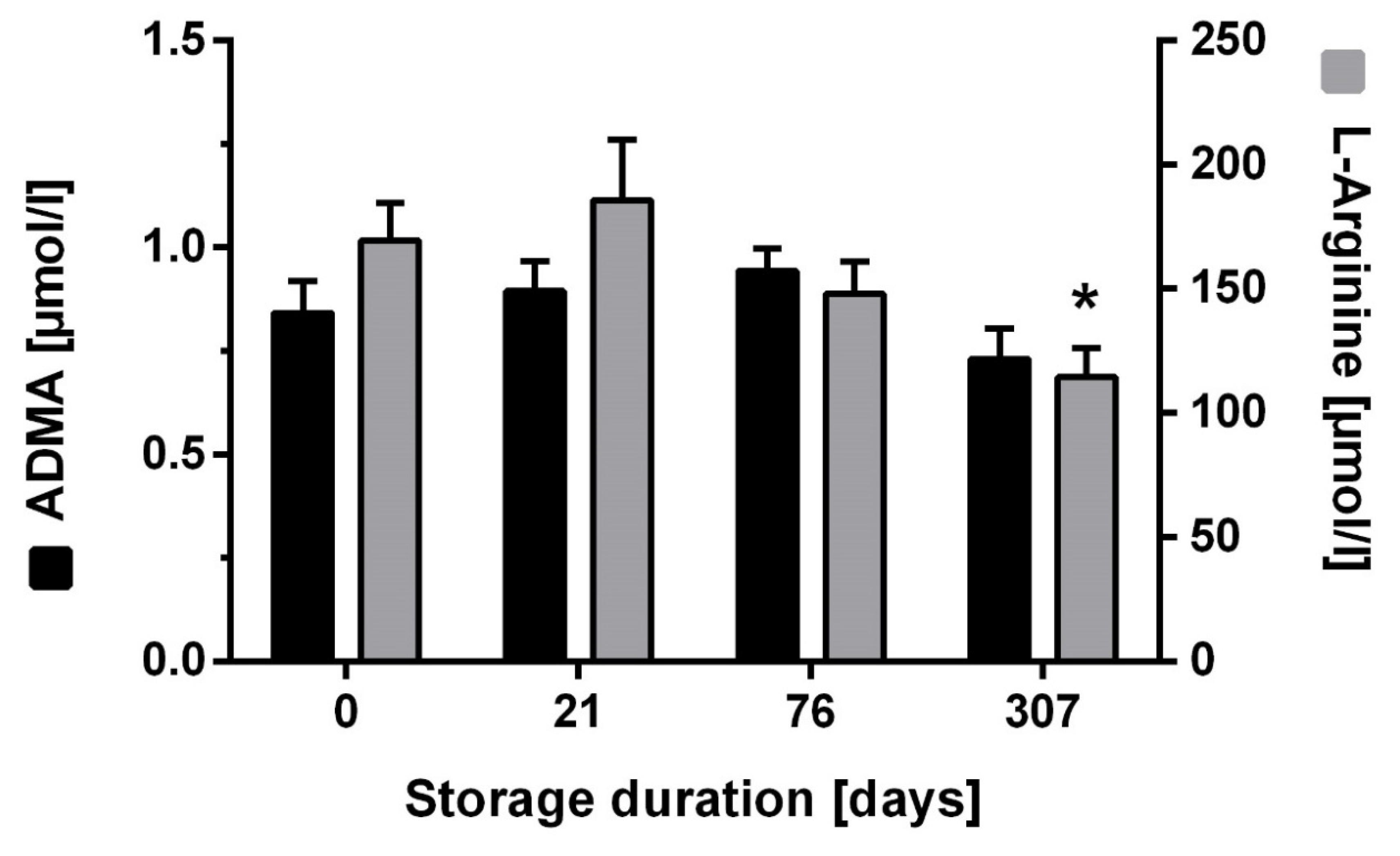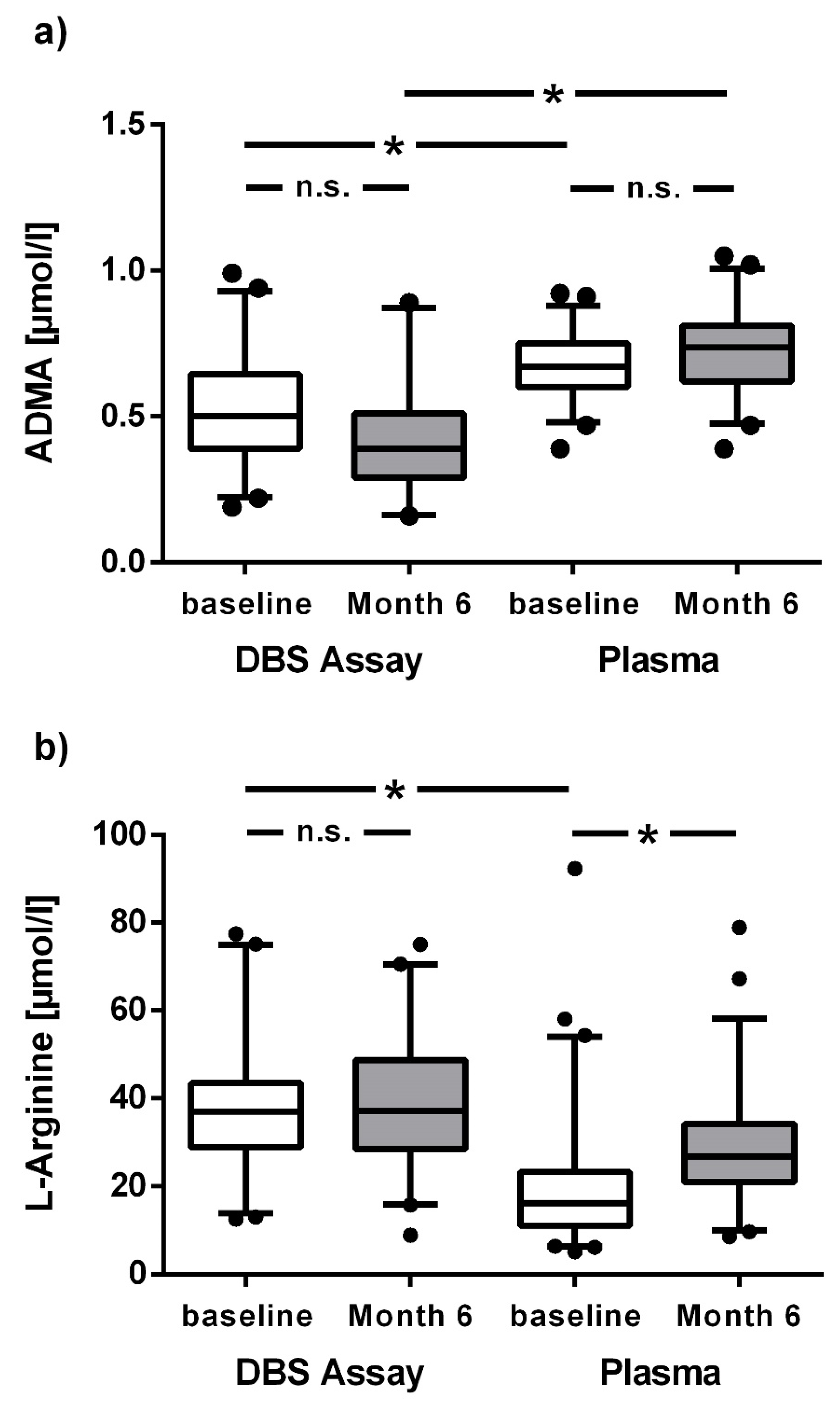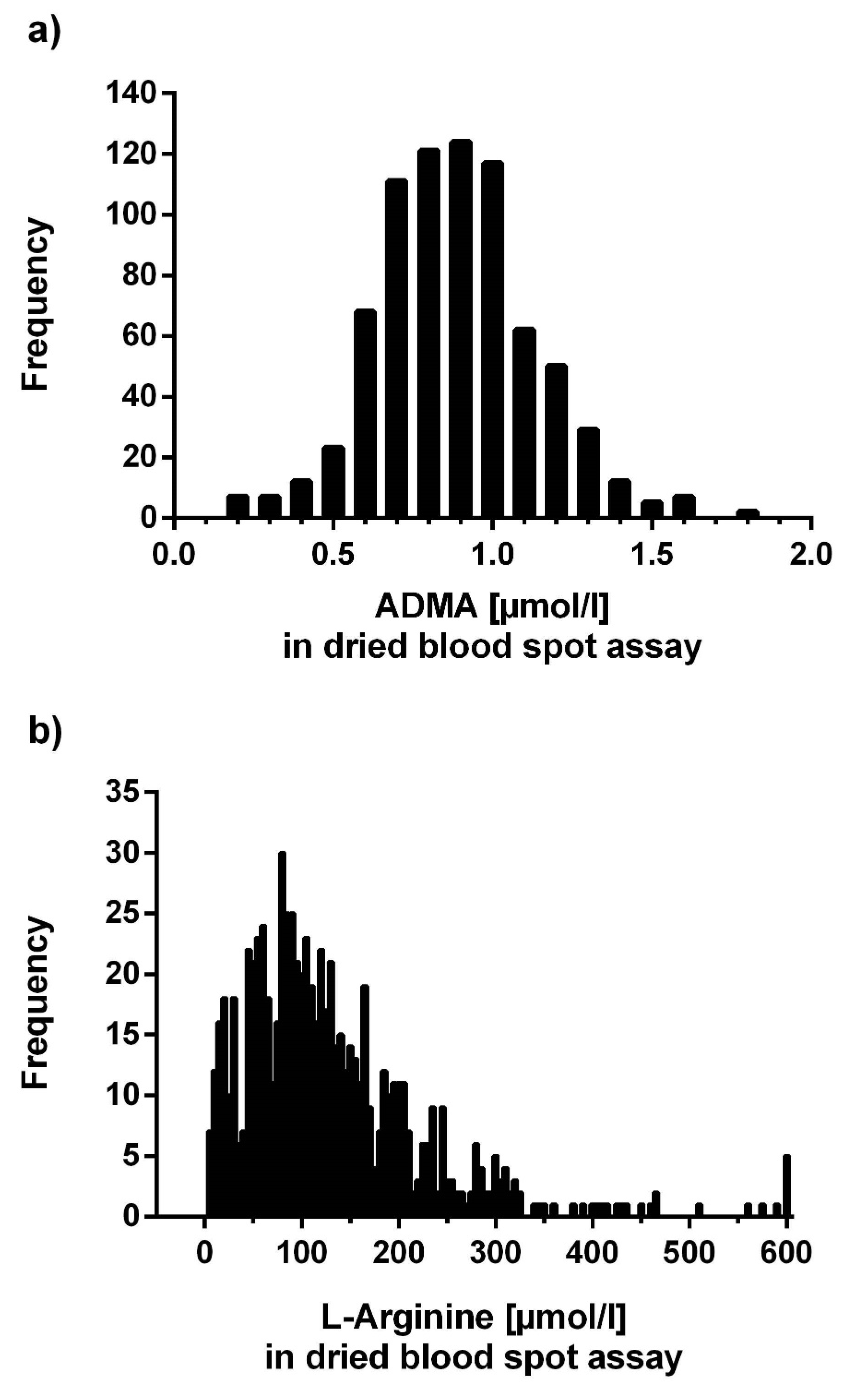Pre-Analytical and Clinical Validation of a Dried Blood Spot Assay for Asymmetric Dimethylarginine and L-Arginine
Abstract
1. Introduction
2. Materials and Methods
2.1. Assay Development and Variabilities
2.2. Analysis of ADMA and L-Arginine in Dried Blood Spots
2.3. Analysis of ADMA and L-Arginine in Plasma Samples
2.4. Influence of Storage Conditions on Assay Results
2.5. ADMA and L-Arginine Concentrations in Dried Blood Spots versus Plasma
2.6. Clinical Validation of the Dried Blood Spot Assay: Healthy Individuals Exposed to Chronic Intermittent Hypoxia
2.7. Clinical Validation of the Dried Blood Spot Assay: Assay Results in Individuals with a Broad Range of Cardiovascular Risk
2.8. Statistical Analyses
3. Results
3.1. Precision and Accuracy of the Dried Blood Spot Assay
3.2. Effects of Pre-Analytical Sample Treatment
3.3. ADMA and L-Arginine Concentrations in Dried Blood Spots versus Plasma
3.4. Clinical Validation of the Dried Blood Spot Assay: Healthy Individuals Exposed to Chronic Intermittent Hypoxia
3.5. Clinical Validation of the Dried Blood Spot Assay: Assay Results in Individuals with a Broad Range of Cardiovascular Risk
4. Discussion
Author Contributions
Funding
Acknowledgments
Conflicts of Interest
References
- Kakimoto, Y.; Akazawa, S. Isolation and identification of N-G,N-G- and N-G,N’-G-dimethyl-arginine, N-epsilon-mono-, di-, and trimethyllysine, and glucosylgalactosyl- and galactosyl-delta-hydroxylysine from human urine. J. Biol. Chem. 1970, 245, 5751–5758. [Google Scholar]
- Gary, J.D.; Clarke, S. RNA and protein interactions modulated by protein arginine methylation. Prog. Nucleic Acid Res. Mol. Biol. 1998, 61, 65–131. [Google Scholar] [CrossRef]
- Böger, R.H.; Sydow, K.; Borlak, J.; Thum, T.; Lenzen, H.; Schubert, B.; Tsikas, D.; Bode-Böger, S.M. LDL cholesterol upregulates synthesis of asymmetrical dimethylarginine in human endothelial cells: Involvement of S-adenosylmethionine-dependent methyltransferases. Circ. Res. 2000, 87, 99–105. [Google Scholar] [CrossRef]
- Vallance, P.; Leone, A.; Calver, A.; Collier, J.; Moncada, S. Accumulation of an endogenous inhibitor of nitric oxide synthesis in chronic renal failure. Lancet (Lond. Engl.) 1992, 339, 572–575. [Google Scholar] [CrossRef]
- Böger, R.H.; Maas, R.; Schulze, F.; Schwedhelm, E. Asymmetric dimethylarginine (ADMA) as a prospective marker of cardiovascular disease and mortality—An update on patient populations with a wide range of cardiovascular risk. Pharmacol. Res. 2009, 60, 481–487. [Google Scholar] [CrossRef]
- Zoccali, C.; Bode-Böger, S.; Mallamaci, F.; Benedetto, F.; Tripepi, G.; Malatino, L.; Cataliotti, A.; Bellanuova, I.; Fermo, I.; Frolich, J.; et al. Plasma concentration of asymmetrical dimethylarginine and mortality in patients with end-stage renal disease: A prospective study. Lancet (Lond. Engl.) 2001, 358, 2113–2117. [Google Scholar] [CrossRef]
- Böger, R.H.; Sullivan, L.M.; Schwedhelm, E.; Wang, T.J.; Maas, R.; Benjamin, E.J.; Schulze, F.; Xanthakis, V.; Benndorf, R.A.; Vasan, R.S. Plasma asymmetric dimethylarginine and incidence of cardiovascular disease and death in the community. Circulation 2009, 119, 1592–1600. [Google Scholar] [CrossRef]
- Leong, T.; Zylberstein, D.; Graham, I.; Lissner, L.; Ward, D.; Fogarty, J.; Bengtsson, C.; Bjorkelund, C.; Thelle, D. Asymmetric dimethylarginine independently predicts fatal and nonfatal myocardial infarction and stroke in women: 24-year follow-up of the population study of women in Gothenburg. Arterioscler. Thromb. Vasc. Biol. 2008, 28, 961–967. [Google Scholar] [CrossRef]
- Böger, R.H.; Ron, E.S. L-Arginine improves vascular function by overcoming deleterious effects of ADMA, a novel cardiovascular risk factor. Altern. Med. Rev. A J. Clin. Ther. 2005, 10, 14–23. [Google Scholar]
- Schulze, F.; Schwedhelm, E.; Maas, R.; Böger, R.H. Comparison of HPLC method and commercial ELISA assay for asymmetric dimethylarginine (ADMA) determination in human serum. J. Chromatogr. B Anal. Technol. Biomed. Life Sci. 2006, 831, 333. [Google Scholar] [CrossRef]
- Schwedhelm, E.; Maas, R.; Tan-Andresen, J.; Schulze, F.; Riederer, U.; Böger, R.H. High-throughput liquid chromatographic-tandem mass spectrometric determination of arginine and dimethylated arginine derivatives in human and mouse plasma. J. Chromatogr. B Anal. Technol. Biomed. Life Sci. 2007, 851, 211–219. [Google Scholar] [CrossRef]
- Schulze, F.; Wesemann, R.; Schwedhelm, E.; Sydow, K.; Albsmeier, J.; Cooke, J.P.; Böger, R.H. Determination of asymmetric dimethylarginine (ADMA) using a novel ELISA assay. Clin. Chem. Lab. Med. 2004, 42, 1377–1383. [Google Scholar] [CrossRef]
- Schwedhelm, E. Quantification of ADMA: Analytical approaches. Vasc. Med. (Lond. Engl.) 2005, 10, S89–S95. [Google Scholar] [CrossRef]
- Barber, B.E.; William, T.; Grigg, M.J.; Piera, K.A.; Chen, Y.; Wang, H.; Weinberg, J.B.; Yeo, T.W.; Anstey, N.M. Nitric oxide-dependent endothelial dysfunction and reduced arginine bioavailability in plasmodium vivax malaria but no greater increase in intravascular hemolysis in severe disease. J. Infect. Dis. 2016, 214, 1557–1564. [Google Scholar] [CrossRef]
- El-Khoury, J.M.; Bunch, D.R.; Reineks, E.; Jackson, R.; Steinle, R.; Wang, S. A simple and fast liquid chromatography-tandem mass spectrometry method for measurement of underivatized L-arginine, symmetric dimethylarginine, and asymmetric dimethylarginine and establishment of the reference ranges. Anal. Bioanal. Chem. 2012, 402, 771–779. [Google Scholar] [CrossRef]
- Miyai, K.; Nishi, K.; Kawashima, M.; Oura, T.; Tsuruhara, T. An improved assay of thyrotropin in dried blood samples on filter paper as a screening test for neonatal hypothyroidism. Clin. Chim. Acta Int. J. Clin. Chem. 1976, 73, 241–249. [Google Scholar] [CrossRef]
- Wilcken, B.; Brown, A.R.; Urwin, R.; Brown, D.A. Cystic fibrosis screening by dried blood spot trypsin assay: Results in 75,000 newborn infants. J. Pediatrics 1983, 102, 383–387. [Google Scholar] [CrossRef]
- Waters, D.L.; Dorney, S.F.; Gaskin, K.J.; Gruca, M.A.; O’Halloran, M.; Wilcken, B. Pancreatic function in infants identified as having cystic fibrosis in a neonatal screening program. New Engl. J. Med. 1990, 322, 303–308. [Google Scholar] [CrossRef]
- Lakshmy, R.; Tarik, M.; Abraham, R.A. Role of dried blood spots in health and disease diagnosis in older adults. Bioanalysis 2014, 6, 3121–3131. [Google Scholar] [CrossRef]
- Siques, P.; Brito, J.; Schwedhelm, E.; Pena, E.; Leon-Velarde, F.; De La Cruz, J.J.; Böger, R.H.; Hannemann, J. Asymmetric dimethylarginine at sea level is a predictive marker of hypoxic pulmonary arterial hypertension at high altitude. Front. Physiol. 2019, 10, 651. [Google Scholar] [CrossRef]
- Böger, R.H.; Bode-Böger, S.M.; Szuba, A.; Tsao, P.S.; Chan, J.R.; Tangphao, O.; Blaschke, T.F.; Cooke, J.P. Asymmetric dimethylarginine (ADMA): A novel risk factor for endothelial dysfunction: Its role in hypercholesterolemia. Circulation 1998, 98, 1842–1847. [Google Scholar] [CrossRef]
- Surdacki, A.; Nowicki, M.; Sandmann, J.; Tsikas, D.; Böger, R.H.; Bode-Böger, S.M.; Kruszelnicka-Kwiatkowska, O.; Kokot, F.; Dubiel, J.S.; Froelich, J.C. Reduced urinary excretion of nitric oxide metabolites and increased plasma levels of asymmetric dimethylarginine in men with essential hypertension. J. Cardiovasc. Pharmacol. 1999, 33, 652–658. [Google Scholar] [CrossRef]
- Krempl, T.K.; Maas, R.; Sydow, K.; Meinertz, T.; Boger, R.H.; Kahler, J. Elevation of asymmetric dimethylarginine in patients with unstable angina and recurrent cardiovascular events. Eur. Heart J. 2005, 26, 1846–1851. [Google Scholar] [CrossRef]
- Schwedhelm, E.; Böger, R.H. Application of gas chromatography-mass spectrometry for analysis of isoprostanes: Their role in cardiovascular disease. Clin. Chem. Lab. Med. 2003, 41, 1552–1561. [Google Scholar] [CrossRef]
- Tsikas, D.; Beckmann, B.; Gutzki, F.M.; Jordan, J. Simultaneous gas chromatography-tandem mass spectrometry quantification of symmetric and asymmetric dimethylarginine in human urine. Anal. Biochem. 2011, 413, 60–62. [Google Scholar] [CrossRef]
- Vallance, P.; Leone, A.; Calver, A.; Collier, J.; Moncada, S. Endogenous dimethylarginine as an inhibitor of nitric oxide synthesis. J. Cardiovasc. Pharmacol. 1992, 20, S60–S62. [Google Scholar] [CrossRef]
- Tsikas, D.; Bohmer, A.; Grosskopf, H.; Beckmann, B.; Dreissigacker, U.; Jordan, J.; Maassen, N. Clinical-chemistry laboratory relevant hemolysis is unlikely to compromise human plasma concentration of free asymmetric dimethylarginine (ADMA). Clin. Biochem. 2012, 45, 1536–1538. [Google Scholar] [CrossRef]
- Teerlink, T.; Luo, Z.; Palm, F.; Wilcox, C.S. Cellular ADMA: Regulation and action. Pharmacol. Res. 2009, 60, 448–460. [Google Scholar] [CrossRef]
- Morris, C.R.; Kato, G.J.; Poljakovic, M.; Wang, X.; Blackwelder, W.C.; Sachdev, V.; Hazen, S.L.; Vichinsky, E.P.; Morris, S.M., Jr.; Gladwin, M.T. Dysregulated arginine metabolism, hemolysis-associated pulmonary hypertension, and mortality in sickle cell disease. JAMA 2005, 294, 81–90. [Google Scholar] [CrossRef]
- Böger, R.H. L-Arginine therapy in cardiovascular pathologies: Beneficial or dangerous? Curr. Opin. Clin. Nutr. Metab. Care 2008, 11, 55–61. [Google Scholar] [CrossRef]








| Median | 95% CI | |
|---|---|---|
| Intraassay variability | (%) | (%) |
| ADMA | 6.7 | 2.7–10.7 |
| L-Arginine | 6.5 | 0.8–12.2 |
| Inter-assay variability | ||
| ADMA | 10.4 | 6.9–13.9 |
| L-Arginine | 11.5 | 8.4–14.6 |
| Day-to-day intraindividual variability | ||
| ADMA | 8.5 | 4.3–12.7 |
| L-Arginine | 17.8 | 9.3–26.4 |
© 2020 by the authors. Licensee MDPI, Basel, Switzerland. This article is an open access article distributed under the terms and conditions of the Creative Commons Attribution (CC BY) license (http://creativecommons.org/licenses/by/4.0/).
Share and Cite
Hannemann, J.; Roskam, T.I.; Eilermann, I.; Siques, P.; Brito, J.; Böger, R. Pre-Analytical and Clinical Validation of a Dried Blood Spot Assay for Asymmetric Dimethylarginine and L-Arginine. J. Clin. Med. 2020, 9, 1072. https://doi.org/10.3390/jcm9041072
Hannemann J, Roskam TI, Eilermann I, Siques P, Brito J, Böger R. Pre-Analytical and Clinical Validation of a Dried Blood Spot Assay for Asymmetric Dimethylarginine and L-Arginine. Journal of Clinical Medicine. 2020; 9(4):1072. https://doi.org/10.3390/jcm9041072
Chicago/Turabian StyleHannemann, Juliane, Thore I. Roskam, Ina Eilermann, Patricia Siques, Julio Brito, and Rainer Böger. 2020. "Pre-Analytical and Clinical Validation of a Dried Blood Spot Assay for Asymmetric Dimethylarginine and L-Arginine" Journal of Clinical Medicine 9, no. 4: 1072. https://doi.org/10.3390/jcm9041072
APA StyleHannemann, J., Roskam, T. I., Eilermann, I., Siques, P., Brito, J., & Böger, R. (2020). Pre-Analytical and Clinical Validation of a Dried Blood Spot Assay for Asymmetric Dimethylarginine and L-Arginine. Journal of Clinical Medicine, 9(4), 1072. https://doi.org/10.3390/jcm9041072








